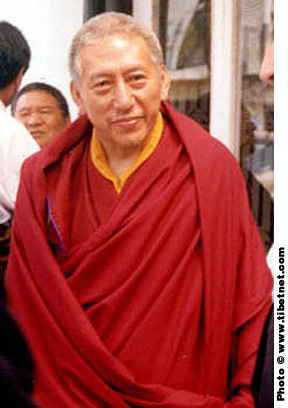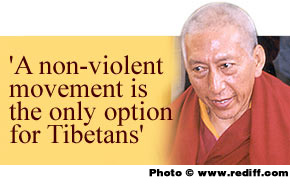

| Tibetan Monk Prepares Exiles for a Political Shift New York Times July 21, 2002 By BARBARA CROSSETTE |
|||||||
 |
He is the portrait of a classic Tibetan Buddhist scholar-monk: calm in countenance, measured in speech, wrapped in monastic robes as he sits in a corner of a small New York hotel room at the start of a North American tour. Samdhong Rinpoche does not look the part of a crucial player in the profound political changes taking place in the Tibetan exile world. At 62, after a long career as a teacher and philosopher, Samdhong Rinpoche (Rinpoche is an honorific for a senior lama) has become the Tibetans' leading political strategist with two big tasks ahead. He has a committee working on plans for a mass noncooperation campaign within Tibet to challenge and maybe flummox Beijing through Gandhi-style passive resistance instead of confrontational protest. Meanwhile, at least for the next four years, he is building a modern democratic system for Tibetan exiles. He is, in effect, preparing Tibet and Tibetans everywhere for a future without the 14th Dalai Lama, their leader for half a century. |
||||||
| "I have an obligation to remain in contact with the people, and America is far away from India," he said. He had just arrived from Dharamsala, the Indian hill town where the Dalai Lama has his exile headquarters. Samdhong Rinpoche is the Dalai Lama's first elected prime minister, or kalon tripa in Tibetan. He was chosen last summer by members of the Tibetan diaspora who pay taxes granting them voting rights to bring some secular organization to a movement that has for decades revolved around the personal charisma, spiritual strength and towering reputation of the Dalai Lama. The Tibetan leader, who was hospitalized early this year and had to cancel a trip to the United States, has been preoccupied with the future, Samdhong Rinpoche said. The Dalai Lama's health is again "perfectly all right," he added. But Tibetans know that sooner or later China will try to impose its own candidate to succeed the Dalai Lama, who is 67, as it did in imposing its own Panchen Lama, the second most important figure in Tibetan Buddhism. Tibetans had already chosen a boy they considered a reincarnation of the Panchen Lama. He disappeared into Chinese custody along with his family. "His Holiness is very anxious to institutionalize the continuity of leadership," Samdhong Rinpoche said.A Constitution has been written and a Parliament in exile given greater power. "The charter provides that when His Holiness does not exist physically, then there would be a provision for appointing a council of regents that would look after His Holiness's temporal responsibility," he said. "So, since there is an elected kalon tripa, there may not be a huge leadership vacuum in the future." |
|||||||
| Samdhong Rinpoche was born in Kham, in eastern Tibet, a region known for its warrior tradition. He fled Lhasa in 1959, just after the Dalai Lama. A distinguished scholar educated at the Drepung Monastery near Lhasa, Samdhong Rinpoche was a leader in establishing schools for Tibetan refugees in the Himalayan hills of India. He later became head of the Central Institute of Higher Tibetan Studies in the Indian holy city of Varanasi. |
 |
||||||
| All the while, he said, he worked on a vision of how to checkmate Chinese rule in Tibet. He zeroed in on Gandhi's tactic of satyagraha, or peaceful resistance, and was planning to retire from academia to teach Tibetans to use it effectively when he was persuaded by the Dalai Lama to be a candidate for prime minister. He got 85 percent of the vote. "We have to empower the people living inside Tibet," Samdhong Rinpoche said. "At this moment, they do not know how to resist in a nonviolent way," he said. "They resist with the slogan of `Independent Tibet' or something like that, and within a few hours they end up in torture or imprisonment and there is nothing they can continue with." Tibetans, inhabitants of what Beijing calls an autonomous region of China, have rights they have not always fully exerted, Samdhong Rinpoche said. "If we resist for that, then China will not find a very easy excuse to imprison them," he said. "They can't say that they are separatists." "The Tibetan people should find their power, and use it," he said. If demands are made within Chinese law, "then the Chinese will find it more difficult to crush them so easily." Samdhong Rinpoche is also plotting a strategy for containing the flow of ethnic Han Chinese into Tibet. "Chinese ethnics are already in a huge majority," he said. "But there is still some hope, because the Chinese populations were until now concentrated in pockets, and there are a huge number of small villages and remote nomads not affected by this population change. What I'm trying to do is to keep those pockets clean. That can be done through noncooperation and nonviolent resistance." However, the real battle is not ethnic or ideological, Samdhong Rinpoche said, adding that he hoped Western supporters understood that there could be accommodation with Beijing if Tibetans were treated justly. "Political separation from China is not important," he said. "What is important is to restore Tibetan civilization. Tibet is not simply a nation or state. It is a unique cultural and spiritual heritage. It could be preserved within China - or it could not be preserved even if we were separate from China. Our basic objective is to preserve it in future for the benefit of all humanity, all sentient beings." "China is not our enemy," Samdhong Rinpoche said. "China is a people who need our cooperation, who need our guidance, spiritually. It has been so for more than 1,000 years." |
|||||||
| xxx | |||||||
|
RETURN TO
www.tibetanliberation.org! Tibetan Liberation Theatre Homepage |
|||||||